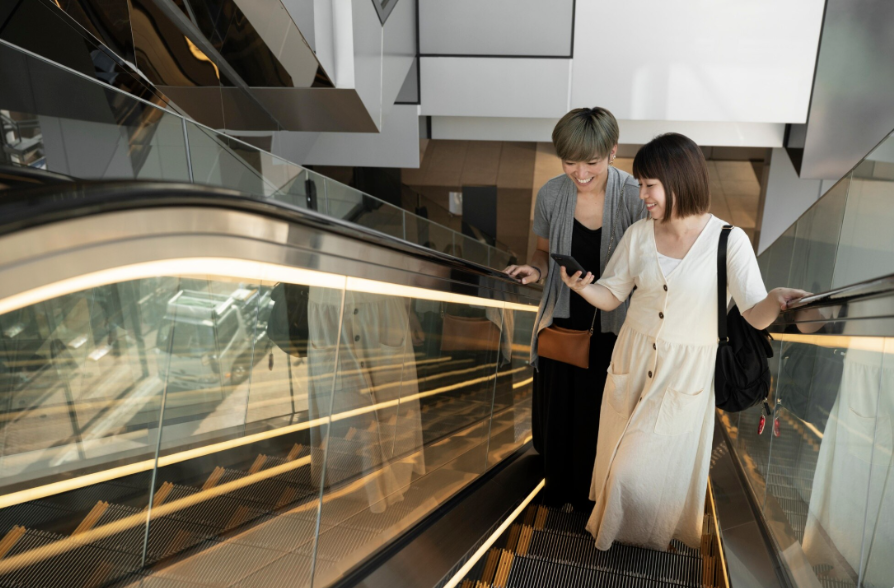Public spaces are constantly under scrutiny. They must move people quickly without compromising safety. Most transit hubs receive thousands of visitors daily.
Without a proper system in place, areas with heavy footfall can be chaotic and stressful. Escalators & autowalks can ease this problem. They can help manage the flow and ease congestion. Elevators also enhance comfort and accessibility for passengers.
Increasing Capacity and Speed
Escalators move people continuously. They operate differently from elevators, which carry only a small group at a time. Escalators also avoid bottlenecks during rush hours. So, they ensure the steady circulation of passengers.
Autowalks offer the same advantage over long distances, such as in terminals or transit corridors, where walking alone may slow down the movement.
Making Best Use of Space
In urban public zones, having unused space is a luxury. Escalators maximize vertical movement without needing a large, wide staircase.
Conversely, autowalks turn long hallways into fast transportation lanes. They free travelers from long walks while keeping the space fully functional.
Accessible for All
Modern infrastructure must be for everyone. Escalators ease movement for all. From the elderly to kids, or people who find stairs challenging, escalators can solve the problem.
Contrarily, autowalks help people with heavy luggage. Together, the two can make public spaces more welcoming, especially for people with challenges.
Traffic Regulation
A steady pace helps manage large crowds. Escalators & autowalks discourage crowding by keeping passengers moving forward in a steady rhythm. Safety features like emergency stop function or anti-skid steps offer an added layer of protection. Many escalators also feature safety sensors to ensure passenger security. Additionally, brushes and clear handrails along the sides prevent accidents from loose clothing or items.
Psychological Comfort
Beyond mechanics, escalators and autowalks also influence how people feel in a busy setting. A continuous, predictable movement eases anxiety and creates order. For travelers, these transit systems provide a sense of mental calmness, making their trip smoother.
Energy Efficiency and Smart Technology
With advances in design, escalators and autowalks have become more intelligent.
These attributes also make them more energy efficient, especially when traffic is low:
- Motion sensors
- Standby modes
- Variable-speed drives
Remote monitoring is another useful smart technology. It enables the early detection of problems. This helps curtail downtime.
Such improvements increase the sustainability rating of a building and reduce operational costs.
Designed for Function and Navigation
Escalators & autowalks double as navigation tools. Their placement directs people toward entrances or exits. They may even lead you to key zones within a large complex.
With strategic placements, they minimize confusion and enable visitors to move naturally between two points. A well-designed system will offer directional support and visually complement the architecture.
Durability and Maintenance
Areas with heavy foot traffic demand robust equipment. Escalators and autowalks are designed to endure constant use and heavy loads.
Weatherproof substances are used for outdoor installations, while modular designs reduce maintenance. Periodic maintenance ensures long-term reliability, so disruptions are rarely noticeable in crowded places.
Real-World Impact
The benefits are evident in practice. Malls reduce waiting time and enhance customer satisfaction when escalators replace bottleneck stairways. Railway and subway stations alleviate rush-hour pressure from massive foot traffic with escalators and autowalks strategically placed where they are needed. With terminals that stretch for miles, autowalks are the primary means of efficiently connecting gates. These facilities transform the experience of moving passengers quickly in public spaces.
The Role of Smart Systems
Escalators and autowalks will continue to evolve with advancing urban spaces.
- Predictive tools can adjust direction or speed in response to real-time passenger flow
- Touchless technology enhances hygiene in crowded areas
- Some eco-friendly designs may soon draw power from a renewable source
The result will be systems that are not just mechanical helpers but integrated parts of intelligent urban infrastructure.
Thus, autowalks and escalators are no longer just public conveniences. They are the essentials of the very transit designs.



